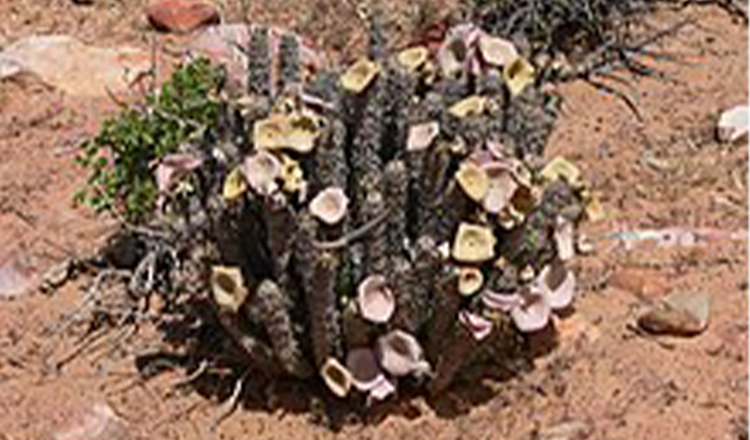Hoodia

Hoodia (/ˈhʊdiə/; known locally as “ghaap” or “bobbejaanghaap”)[1] is a genus of flowering plants in the family Apocynaceae, under the subfamily Asclepiadoideae, native to Southern Africa.[2]
One species of Hoodia in particular, Hoodia gordonii, has achieved a degree of fame and controversy, after being investigated for use as a possible appetite suppressant.
Description
Hoodia officinalis
Hoodia macrantha
The group was first described as a genus in 1844.[3][4]
Hoodia are stem succulents, described as “cactiform” because of their remarkable similarity to the unrelated cactus family. They have a branching, shrub-like form, and the largest species (Hoodia parviflora) can grow to the size of a tree — over 2 m (6 ft 7 in) in height.
The flowers are extremely variable in size — from less than 1 cm, to almost 20 cm in diameter, depending on the species. Flowers appear in large numbers, always near the tops of the stems. Those of larger-flowered species (such as Hoodia gordonii) are often a papery pink-tan colour, plate-shaped, with an unpleasant smell to attract their fly pollinators. The smaller, darker flowers of some species have a far stronger and more unpleasant smell than the larger flowers.
Distribution
The genus Hoodia is restricted to the arid regions in the western part of southern Africa, ranging from western South Africa to central Namibia and as far north as southern Angola. It is especially common in the Namib desert and in the Orange River valley. Typical habitat is rocky slopes and open stone plains. Plants usually germinate in the shelter of bushes or rocks, but survive in the open as adult plants.
